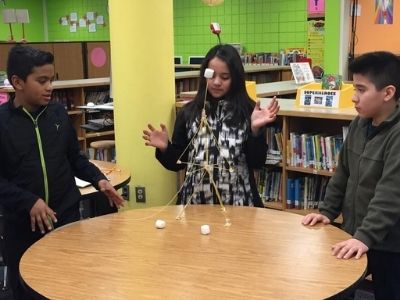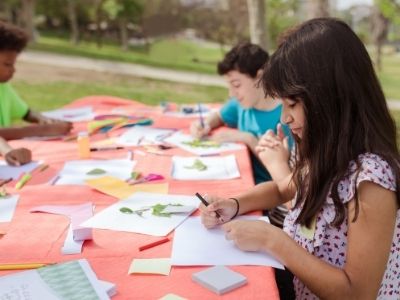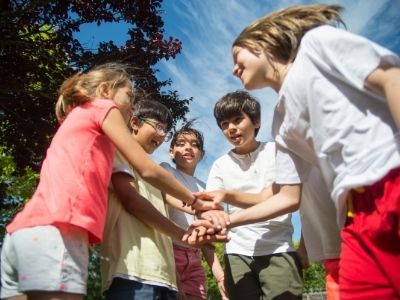Students can use team-building activities to enhance critical thinking abilities that will help them succeed in the modern workplace. Teamwork-oriented students (and future employers!) are more motivated and creative. We all know how much students like working in groups. Why not turn it into a game? While brain training activities can be used to assist kids to develop lateral thinking, games are usually a superior solution. Try them out in your classrooms to help students think critically and collaborate more effectively.
Minefield
Minefield is a traditional team-building activity that encourages kids to communicate and trust one another. It entails the creation of an obstacle course and the division of pupils into teams. Students take turns blindfolded piloting the “minefield,” with only their colleagues’ assistance to guide them. You might also urge students to use specific words or clues to make it tougher or content-area specific to make it more engaging.
If You Build it
This team-building activity is very adaptable. To begin, divide kids into teams and distribute equal amounts of a certain material, such as pipe cleaners, blocks, or dried spaghetti and marshmallows.

Then give them a project to work on. The challenge can vary (for example, which team can construct the largest, most structurally sound castle?). Which side can construct the most castles in the shortest amount of time?). By changing the challenge or materials to certain curriculum areas, you can recycle this activity throughout the year.
Zoom
When it comes to team building games, Zoom is a classic, and the game’s various benefits make it even more fascinating. Children sit in a circle and are each given a picture of an object in Zoom. The game starts with one youngster telling a tale about the picture on his or her hand, and the next student picks up where the prior student left off. By forcing kids to think on their feet when creating the stories, the game aids in the development of their imagination, critical thinking, and communication skills.

Also find vocabulary building activities suitable for students.
Save the Egg
Each team of three or four people will drop their egg from a certain height in this game. They need to think of ways to keep the egg from breaking during the fall. They can use whatever objects they want to make a gentle landing or some sort of gadget to ensure the egg lands safely.
Because this one might get nasty, it’s crucial to choose a secure location where no one will be concerned about damaging precious school property.
The Worst-Case Scenario
Students are placed into two or more groups, with each group being assigned a challenging situation, such as becoming lost at sea or being left on a deserted island. They are then instructed to work together in their teams to solve the problem and emerge victoriously. The kids must devise a plan to ensure that everyone survives the worst-case scenario.

In this example, children can be asked to evaluate the objects they will need in such a scenario, as well as any other passages they may come across. Because children are obliged to work together, it aids in the development of their problem-solving skills and teaches them the value of teamwork.
It’s a Mystery
Many children (and growing ones) like good mysteries, so why not create one that requires youngsters to work together to solve? Each kid should be given a numbered clue. To solve the mystery—for example, the case of the missing mascot—children must work together to answer the clues in order to give time. The “case” may need them to walk from one area of the room to another to unearth new clues.
Keep it Real
This open-ended model serves as an effective exam for pupils because it is based on a simple premise that promotes dialogue and problem-solving. Assign pupils the task of detecting and resolving a real problem in their schools or communities. Certain constraints, such as time limits, materials, and physical limitations, could be imposed to assist children in determining their limits.
Shrinking Vessel
With brain training, critical thinking might be difficult to grasp; yet, with entertaining team building games like a shrinking vessel, it becomes second nature. The activity begins with members being divided into small groups. Each group must work together to squeeze into a diminishing space until there is no more room. Cones or a rope can be used to create the boundary. This game teaches you how to work in a group and solve problems.
Go for Gold
This game is similar to ‘If you construct it,’ in that teams share a common goal, but instead of having the same materials, they have access to a large supply. For example, the goal might be to build a device out of pipes, rubber tubing, and cardboard that can transport marble from point A to point B in a specific number of steps using just gravity.
While textbook education is important, educators must guarantee that students communicate well with one another. Team-building exercises are an excellent method to accomplish this, and they will never go out of trend.
At TIST, we always follow the best activities suited for our students’ growth. We have various clubs, multi-purpose halls, play areas that are well suited for enhancing the students’ extracurricular activities.

